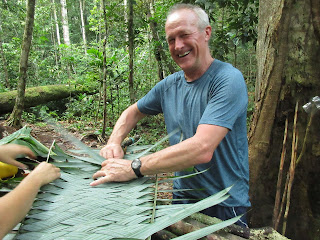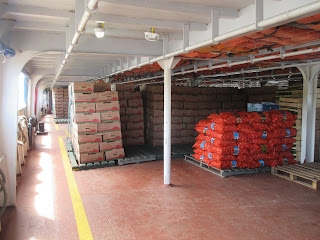A night in the Amazon Jungle.
We had an in depth explanation of how manioc flour is made from the tubers. They are peeled and then shredded into little pieces. Then the pulp is left to soak in water for a short while. The pulp is then squashed to extract all the water. The dry pulp is sieved to remove the larger pieces and then is it lightly roasted until dry. This produces a rough flour from which patties and a host of other products can be made. The process also extracts all the toxins which in its raw form is poisonous.
Roasting the flour in a large cauldron above a fire.
Tossing the manioc.
A mid morning snack back in the farmhouse, tea, coffee, patties, pittas, bread.
Then it is a walk into the jungle and after a days walk, we spread some tarps over some poles.
The two tarps with our hummocks underneath with a fire in the foreground.
Some people preferred to set their hummocks up between some trees.
Setting a hummock between two trees was great in the afternoon when the sky was clear but it would all change over night. A front came over and it started to rain. There are many noises in the jungle at night but the rain falling on the leaves and then falling onto lower leaves and finally on to the leaves on the jungle floor creates quite a bit of noise and is fairly distinctive. as the rain front advances.
I heard it coming but it was of little concern as I was under the tarp. The rain finally arrived in camp and it poured down. Anne was already up and moving her hummock under the tarp. Others stuck it out, hoping that it would blow over but no such luck. I got up and sped the last strugglers to untie their hummocks and carry them to the relatively drier area under the tarps and retie them there to sleep in for the rest of the night.
Next we had to collect one wood for the fire and we all had a chance to carry wood back to the camp. Here is Kieran and Simone with just one of many logs destined for the fire.
Jungle James and Jungle Boy (real name Amilton) started cutting sticks with a point at each end. We had to go into the jungle and find particular palm and cut of a leaf.
We then had to fold the leaf and hold it together with the double pointed stick, something like a cocktail stick and that would be our bowl for the evening meal as demonstrated by Rosie.
T
hen we needed some shavings to get a fire going, yet another use for the machete.
And a clean surface for preparation, washing etc so time to split a palm frond along the stem and then weave the little leaves together.
And what you saw above wasn't all my own work as the credit ought to go to the person that had started and done most of the hard work, Amy.
The next day we had another trek through the jungle learning about how it can provide food, shelter, medicines, goods to trade etc. And other ways or using plants to light fires from the flammable oils contained within them, such as shredding this palm which was ever some much easier than using the machete to create shavings from wood. However this was after I had shaved some wood to start the fire the night before whilst there was a fire lighting palm right next to the camp site.
So it was with a great feeling of relief that we got back to the lodge the next day and back to hummocks under cover and toilets and showers (although we had by now got used to cold water from the river to use in the toilets and showers and finding a bit of privacy behind a palm wasn't so unusual after the first few days).
Then is was an hour trip down river and a 200kms drive to get back to Manaus.








































































